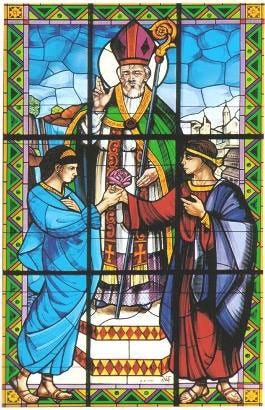This has been the week that February masquerades as April: blue skies, 63 degrees F, blinding glare from the white orb in the sky, warmth on skin, and mud underfoot. It’s only on loan; we’ll repay it with a late April snowstorm. But for now, how glorious! A taste of Spring to spur us to plan out the garden and start indoor seeds. A false Midwest Spring before the onset of Second Winter.
Not without its touch of sorrow, though. My eager visit to the sun-drenched hive, with expectations of bees taking off on cleansing flights (they fly away from their communal home on warm days in order to poop), brought only disappointment. No bees at the entrance, no vibrating hum of the walls, no buzzing sounds or nosy bees when I removed the roof. Phillip confirmed it with a closer look into the hive. We’re presuming the last freeze caused their demise. Very disappointing.
Will the real St. Valentine please step forward?
As opposed to Valentine’s Day being a “Hallmark holiday” created by greeting card companies and candy makers (as I presumed for many years), it turns out the now mainly secular holiday was originally an official Church feast day. I had thought that St. Valentine had been removed from the official register of Roman Catholic saints due to being unmasked as a figure of legend, like St. Christopher. Technically, St. Christopher is still a saint, but he lost his universal feast day and the Vatican said there wasn’t enough evidence that he’d actually existed. I suspect the tales of him being over 7 feet tall and sprouting the head of a dog didn’t help his case. He’s still venerated in the Eastern Orthodox tradition, which means amazing icons.1
Back to St. Valentine: it turns out that he, like St. Christopher, lost his universal RC feast day in 1969, being relegated to a local feast day that could be celebrated as long as there wasn’t a more important religious feast on that day. The popularity of the name “Valentine” in the 4th century Roman Empire has created some confusion over who the saint is. There were possibly 2 Valentines who were priests or bishops in Rome, martyred the same day, and buried near each other. A 3rd Valentine was martyred around the same time in part of the Roman Empire in Africa. There was also a 4th century St. Valentina, and no less than 11 other St. Valentines stretching into the 20th century. The one who lent his name to our February 142 celebration of love is the one (or two) clerical martyr(s) buried on the Via Flaminia3 outside Rome.

Why all the hearts and talk of love on his feast day? Possibilities include: 1) He signed his last letter to a friend from prison “Your Valentine.” 2) He secretly officiated Christian wedding ceremonies, which was against the emperor’s decrees. 3) He cut out heart shapes from parchment & gave them as reminders of the commandment to love one another (incidentally making him a candidate for patron saint of kindergarten teachers & Pinterest influencers). 4) Chaucer linked the saint’s feast day to romance with a line in a poem: “For this was on Saint Valentine’s Day, when every bird comes there to choose his mate.” 5) Medieval Europeans, with their rather obsessive regard for courtly love, needed a saint to bless their customs. 6) It was a way to Christianize the annual Roman festival of Lupercalia, February 13-15.
As St. Valentine is also a patron saint of beekeepers, I’ll be grateful for any help he can provide in that domain. This year, Valentine’s Day falls on Ash Wednesday, the beginning of Lent, so we’ll have to enjoy our candy hearts on Mardi Gras instead.
Happy Valentine’s Day to you all! And Good New Year to you as we enter the Year of the Dragon! I’ll leave you with a music video of a talented trio of Tuvan throat singers, Alash, whom we were fortunate to see perform locally this weekend.
—Erin, in Michigan
Though maybe I should give St. Christopher a chance. He is, after all, one of the Fourteen Holy Helpers, patron saint of gardeners, and patron of the city in Germany that some of my farming ancestors emigrated from.
February 14 is St. Valentine’s feast day in the Anglican and Lutheran calendars as well. In Eastern Orthodoxy, it is celebrated on July 6.
The Via Flaminia is the road on which Constantine had his conversion experience that lead to the Christianization of the Roman Empire. The road remained of importance through multiple wars and conquests, including during WWII.









I’m so sorry to hear your bees didn’t make it—quite heartbreaking, really. Will you acquire another colony this Spring?
On a more pleasant note…I so enjoyed your Suburb Farm spin on St. Valentine’s celebrations, and how you brought it all together: where Roman festivals meet saints’ feast days meet the traditional rhythms of agriculture!